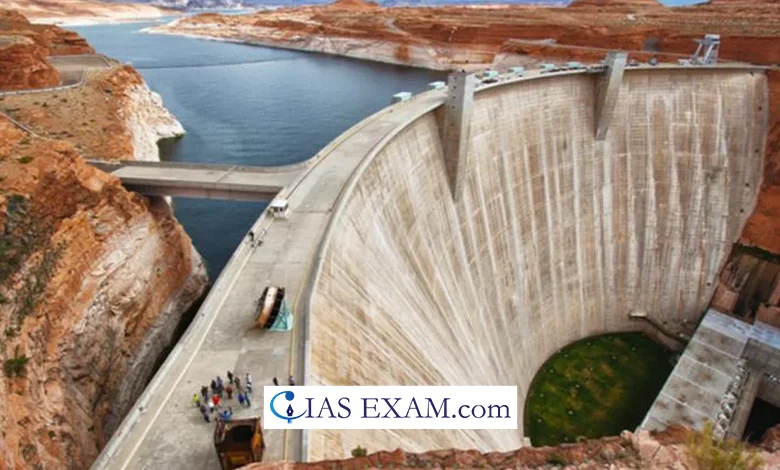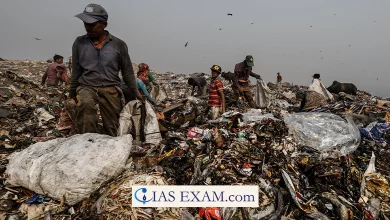Daily Current Affairs for UPSC
Hydropower Concerns due to Climate Change
Syllabus - Environment [GS Paper-3]

Context
Droughts and floods damaging hydropower dams are made more frequent and severe by climate change are an “increasing concern” for hydropower.
Key Highlights
- Recent droughts in Colombia and Ecuador have significantly hampered electricity provided by hydropower.
- This has led Ecuador to claim a state of emergency and institute power cuts.
- Hydropower gives over 80% of electricity requirements in the Democratic Republic of Congo, Ethiopia, Malawi, Mozambique, Uganda and Zambia — many of which are also suffering from severe droughts.
What is Hydropower?
- Hydropower, or hydroelectric energy, is one of the oldest and biggest sources of renewable strength, which uses the herbal flow of transferring water to generate energy.
- Hydropower currently generates more electricity than all other renewable technology combined and is expected to remain the world’s largest source of renewable energy generation into the 2030s.
- Classification of Hydro Projects based on Installed Capacity:
- Micro: upto 100 KW
- Mini: 101KW to 2 MW
- Small: 2 MW to 25 MW
- Mega: Hydro project with established potential >= 500 MW
- India: In 2022-23, hydropower accounted for 12.5 percent of energy generation in India. India had about 4745.6 MW pumped storage capacity in operation in 2023.
- The hilly States of India in particular Arunachal Pradesh, Himachal Pradesh, Jammu & Kashmir and Uttarakhand constitute around half of this capacity.
- Other capacity States are Maharashtra, Chhattisgarh, Karnataka and Kerala.
Significance of Hydro Power
- Renewable Energy Source: Hydropower is a renewable power supply as it is based on the water cycle, that’s constantly replenished by rainfall and snowmelt.
- This makes it a sustainable alternative to fossil fuels that are finite and contribute to climate change by greenhouse gas emissions.
- Clean Energy: Hydropower produces minimum greenhouse gas emissions compared to fossil fuels, making it an environmentally friendly option for generating electricity.
- Reliable and Predictable: Unlike solar and wind power, which are intermittent and depending on weather conditions, hydropower affords a regular and reliable source of power.
- Flexible and Controllable: Hydropower plants can quickly modify their output to in shape adjustments in electricity demand.
- Multipurpose Use: Hydropower projects often serve a couple of functions beyond power technology.
- They can provide flood control by regulating water waft, irrigation for agriculture, water supply for communities, and recreational opportunities along with boating and fishing.
- Long Lifespan: Hydropower infrastructure, consisting of dams and turbines, may have long lifespans, regularly exceeding 50 years with right protection. This durability ensures a stable and enduring source of energy for an extended period of time.
Challenges
- Environmental Impact: Large-scale hydropower initiatives frequently require damming rivers, which change ecosystems, disrupt fish habitats, and affect nearby biodiversity.
- It also ends in problems like sediment buildup and water temperature modifications downstream, affecting aquatic life.
- Social Impacts: Building dams and reservoirs displace communities and disrupt livelihoods, especially the ones counting on the affected rivers for fishing or agriculture.
- High Initial Costs: Constructing hydropower centers includes good sized in advance funding expenses.
- Climate Change Vulnerability: Hydropower technology is based on strong water flow, which may be suffering from climate change-brought on variations in precipitation patterns and glacial melt.
- A UK based think tank discovered that the drought — probably exacerbated by weather alternate — drove an 8.5% drop in hydroelectricity around the world over the last years.
- Sedimentation: Dams trap sediment flowing downstream, main to reservoirs regularly filling up with sediment through the years.
- This reduces the reservoir’s capacity and affects the performance and lifespan of the hydropower facility.
- Maintenance Challenges: Hydropower infrastructure requires regular upkeep to ensure secure and efficient operation.
Way Ahead
- The solution for the country is to diversify their electricity assets by incorporating different renewable technologies — including wind and solar — into their energy mix.
- Innovations around putting floating solar panels at the water’s floor in hydropower flowers — as countries such China and Brazil are exploring — have extensive capacity.
- Building greater medium scale flora, in place of the mega dams of the past, could assist mitigate the climate-risks related to overdependence on one huge piece of infrastructure.
- Without important coverage adjustments, worldwide hydropower growth is expected to slow down this decade.
Source: The Indian Express
UPSC Mains Practice Question
Q. Analyse the potential of hydroelectric power in meeting world’s electricity demands? What are the associated concerns regarding hydro power generation?





.png)



